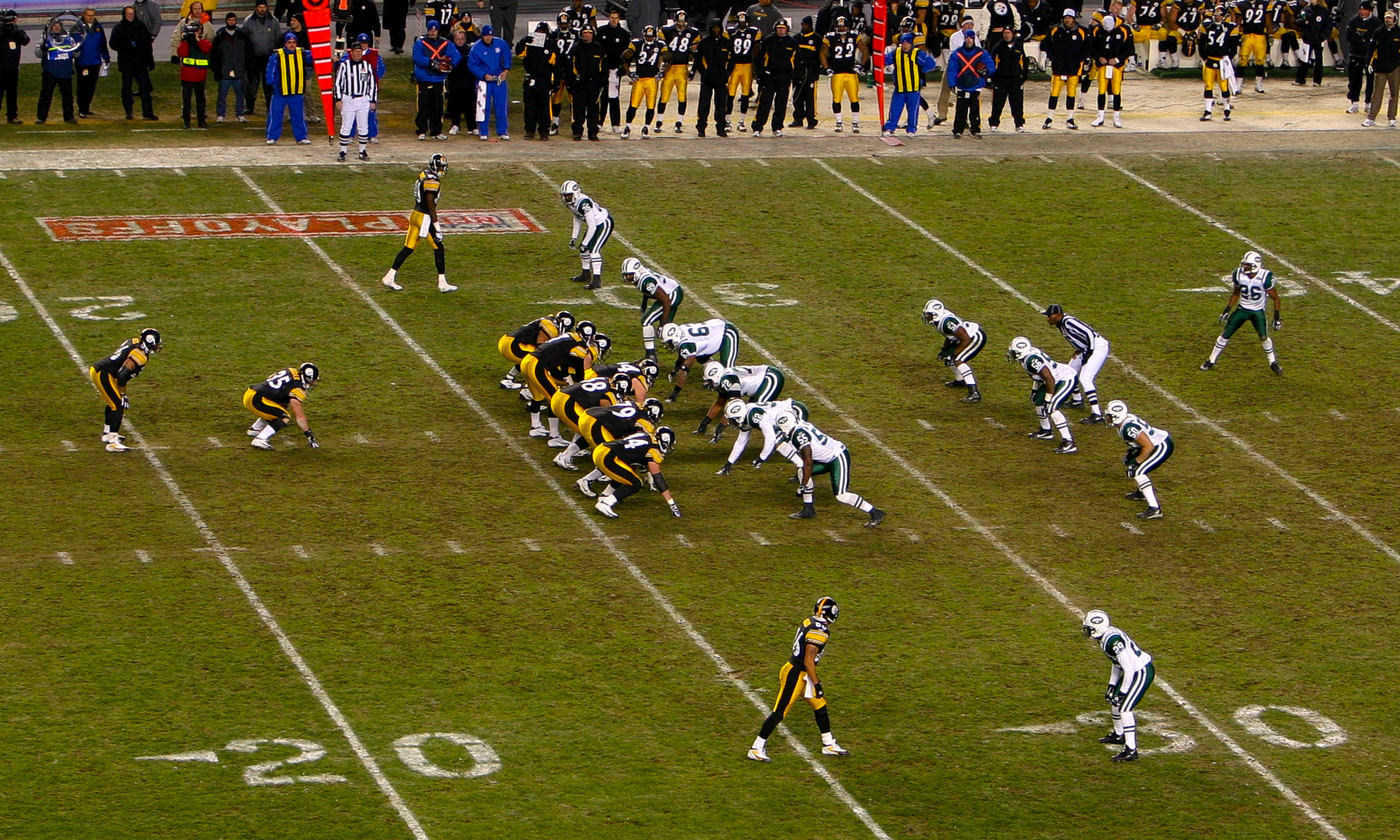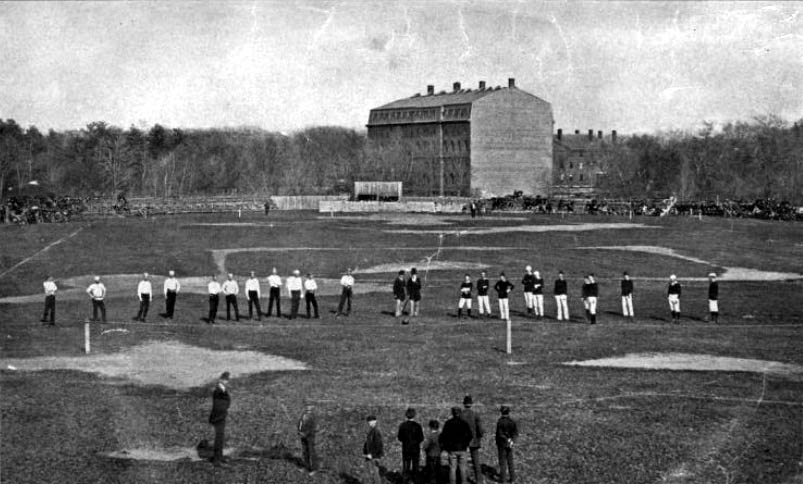|
Shift (gridiron Football)
In gridiron football, a shift refers to the movement of an offensive player prior to the snap. Motion and shift There is a distinction drawn between a ''shift'' and ''motion'' in football. Motion occurs when a player is moving ''at the time of the snap''. A shift occurs when one or more players changes their position on the offensive side of the ball ''before the snap'', causing a change in formation. For example, players may line up initially in an I-formation and then shift the two running backs into wide receiver positions to put the offense in a spread formation. A team may shift any number of players into new positions, so long as they all come to a complete stop for a full second before the ball is snapped to start the play. The National Football League defines all motion and shift penalties as "illegal motion", while both the NCAA and NFHSAA make a distinction between an "illegal shift" and "illegal motion"; an illegal shift refers to players shifting and not coming ... [...More Info...] [...Related Items...] OR: [Wikipedia] [Google] [Baidu] |
Gridiron Football
Gridiron football,"Gridiron football" ''Encyclopædia Britannica''. Retrieved October 20, 2010. also known as North American football or, in North America, simply football, is a family of football team sports primarily played in the and . |
Offense (sports)
In sports, offense ( American spelling) or offence ( Commonwealth spelling, see spelling differences; pronounced with first-syllable stress; from Latin '' offensus''), known as attack outside of North America, is the action of attacking or engaging an opposing team with the objective of scoring points or goals. The term may refer to the tactics involved in offense, or a sub-team whose primary responsibility is offense. Generally, goals are scored by teams' offenses, but in sports such as American football it is common to see defenses and special teams (which serve as a team's offensive unit on kicking plays and defensive on returning plays) score as well. The fielding side in cricket is also generally known as the ''bowling attack'' despite the batting side being the side that scores runs, because they can prevent batting players from scoring by getting them out, and end the batting team's scoring turn by getting them all out. In countries outside North America, the term ''o ... [...More Info...] [...Related Items...] OR: [Wikipedia] [Google] [Baidu] |
Snap (football)
A snap (colloquially called a "hike", "snapback", or "pass from center") is the backward passing of the ball in gridiron football at the start of play from scrimmage. Action The ball begins on the ground with its long axis parallel to the sidelines of the field, its ends marking each team's line of scrimmage in American football; in Canadian football, the line of scrimmage of the team without the ball is 1 yard past their side of the ball. The player snapping the ball (known officially as the "snapper" in rule books) delivers the ball to another player, and that action is the snap. The snapper may hand, throw, or even roll the ball to the other player. The snap must be a quick and continuous movement of the ball by one or both hands of the snapper, and the ball must leave the snapper's hands. The various rules codes have additional requirements, all of which have the effect of requiring the ball to go backward. The snapper almost always passes the ball between his legs, but on ... [...More Info...] [...Related Items...] OR: [Wikipedia] [Google] [Baidu] |
Motion (gridiron Football)
In gridiron football, motion refers to the movement of an offensive player at the time of the snap. While there are different rules regarding motion, most mandate that no more than one player may be in motion at the time of the snap, and the player must not be an offensive lineman (typically, the player in motion is a wide receiver or running back). Additionally, the NFL (professional), NCAA (college), and NFHSAA (high school) require that they be moving laterally or backwards; they are not allowed to be moving towards the line of scrimmage when the ball is snapped. The Canadian Football League and the Arena Football League allow for motion towards the line of scrimmage at the time of the snap. Motion and shift There is a distinction drawn between a ''shift'' and ''motion'' in football. Motion occurs when a player is moving ''at the time of the snap''. A shift occurs when one or more players changes their position on the offensive side of the ball ''before the snap'', causing a ... [...More Info...] [...Related Items...] OR: [Wikipedia] [Google] [Baidu] |
I-formation
The I formation is one of the most common offensive formations in American football. The I formation draws its name from the vertical (as viewed from the opposing endzone) alignment of quarterback, fullback, and running back, particularly when contrasted with the same players' alignments in the ''T formation''. The formation begins with the usual 5 offensive linemen (2 offensive tackles, 2 guards, and a center), the quarterback under center, and two backs in-line behind the quarterback. The base variant adds a tight end to one side of the line and two wide receivers, one at each end of the line. History The exact origin of the I formation is unclear. Charles M. Hollister of Northwestern in 1900 is one source, as is Bob Zuppke in 1914. Tom Nugent is credited with developing the I formation at Virginia Military Institute in 1950 as a replacement for the single-wing and an alternative to the T formation. Don Coryell, before popularizing Air Coryell, was also a pioneer ... [...More Info...] [...Related Items...] OR: [Wikipedia] [Google] [Baidu] |
Spread Formation
Spread may refer to: Places * Spread, West Virginia Arts, entertainment, and media * ''Spread'' (film), a 2009 film. * ''$pread'', a quarterly magazine by and for sex workers * "Spread", a song by OutKast from their 2003 album '' Speakerboxxx/The Love Below'' * Spreadability, a concept in media studies * Page spread, an aspect of book design Finance * Spread, the difference in price between related securities, as in: ** Bid–offer spread, between the buying and selling price of a commodity and/or security ** Credit spread (bond), on bonds ** Option-adjusted spread, on mortgage backed securities where the borrower has the right to repay in full ** Options spread, building blocks of option trading strategies. ** Spread trade, between two related securities or commodities *** Spread option, payoff is based on the difference in price between two underlying assets ** Yield spread, difference in percentage rate of return of two instruments ** Z-spread, on mortgage backed se ... [...More Info...] [...Related Items...] OR: [Wikipedia] [Google] [Baidu] |
Amos Alonzo Stagg
Amos Alonzo Stagg (August 16, 1862 – March 17, 1965) was an American athlete and college coach in multiple sports, primarily American football. He served as the head football coach at the International YMCA Training School (now called Springfield College) (1890–1891), the University of Chicago (1892–1932), and the College of the Pacific (1933–1946), compiling a career college football record of . His undefeated Chicago Maroons teams of 1905 and 1913 were recognized as national champions. He was also the head basketball coach for one season at Chicago (1920–1921), and the Maroons' head baseball coach for nineteen seasons (1893–1905, 1907–1913). At Chicago, Stagg also instituted an annual prep basketball tournament and track meet. Both drew the top high school teams and athletes from around the United States. Stagg played football as an end at Yale University and was selected to the first All-America Team in 1889. He was inducted into the College Football ... [...More Info...] [...Related Items...] OR: [Wikipedia] [Google] [Baidu] |
College Football
College football (french: Football universitaire) refers to gridiron football played by teams of student athletes. It was through college football play that American football rules first gained popularity in the United States. Unlike most other sports in North America, no official minor league farm organizations exist in American or Canadian football. Therefore, college football is generally considered to be the second tier of American and Canadian football; one step ahead of high school competition, and one step below professional competition (the NFL). In some areas of the US, especially the South and the Midwest, college football is more popular than professional football, and for much of the 20th century college football was seen as more prestigious. A player's performance in college football directly impacts his chances of playing professional football. The best collegiate players will typically declare for the professional draft after three to four years of collegia ... [...More Info...] [...Related Items...] OR: [Wikipedia] [Google] [Baidu] |
Minnesota Shift
The Minnesota shift is an American football offensive maneuver that was a forerunner of other shifts and pre-snap formation changes in the game. It consists of a sudden switch into a new offensive formation immediately before the ball is snapped with the intent of keeping the defense off balance and disguising the intended point of attack. University of Minnesota Golden Gophers coach Dr. Henry L. Williams is credited with its invention in the first decade of the 20th century, and his institution lends its name to the shift. The maneuver gained national attention when it was adopted by period powerhouse Yale University in 1910. Williams, an 1891 graduate of Yale, had earlier repeatedly offered to mentor his alma mater in the formation, but was rebuffed because the Elis would "not akefootball lessons from a Western university." In 1910, the Elis suffered early season setbacks at the hands of inferior opponents, and sought an advantage to use in its game against strong Princeton an ... [...More Info...] [...Related Items...] OR: [Wikipedia] [Google] [Baidu] |
Henry L
Henry may refer to: People * Henry (given name) * Henry (surname) * Henry Lau, Canadian singer and musician who performs under the mononym Henry Royalty * Portuguese royalty ** King-Cardinal Henry, King of Portugal ** Henry, Count of Portugal, Henry of Burgundy, Count of Portugal (father of Portugal's first king) ** Prince Henry the Navigator, Infante of Portugal ** Infante Henrique, Duke of Coimbra (born 1949), the sixth in line to Portuguese throne * King of Germany ** Henry the Fowler (876–936), first king of Germany * King of Scots (in name, at least) ** Henry Stuart, Lord Darnley (1545/6–1567), consort of Mary, queen of Scots ** Henry Benedict Stuart, the 'Cardinal Duke of York', brother of Bonnie Prince Charlie, who was hailed by Jacobites as Henry IX * Four kings of Castile: ** Henry I of Castile ** Henry II of Castile ** Henry III of Castile ** Henry IV of Castile * Five kings of France, spelt ''Henri'' in Modern French since the Renaissance to italianize the ... [...More Info...] [...Related Items...] OR: [Wikipedia] [Google] [Baidu] |
Jump Shift
The jump shift or Heisman shift, was an American football shift maneuver utilized by John Heisman John William Heisman (October 23, 1869 – October 3, 1936) was a player and coach of American football, baseball, and basketball, as well as a sportswriter and actor. He served as the head football coach at Oberlin College, Buchtel College .... In this system, only the center was on the line of scrimmage, and the backfield would be in a line, as one would in an I-formation with an extra halfback at the hind end, or a giant T. The players could shift into various formations. In one version, the line shifted so that the center was between guard and tackle, and the three backs nearest the line of scrimmage would shift all to one side. A split second elapsed, then the ball was snapped and the wall of three blockers charged on. If needed, the center could also snap it to one of the other backs. The phalanx of blockers resembled the yet-to-be developed single wing. The Heism ... [...More Info...] [...Related Items...] OR: [Wikipedia] [Google] [Baidu] |





